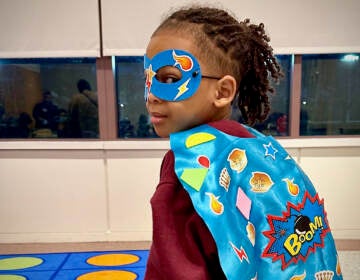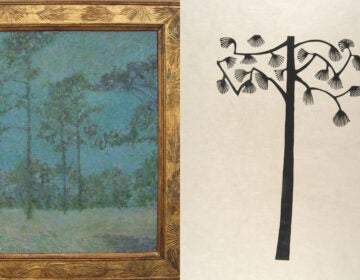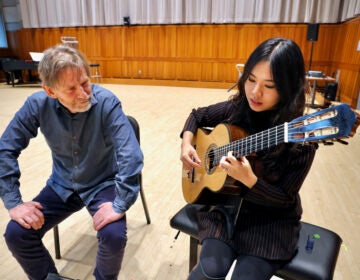National Liberty Museum amplifies the liberating power of music
The Old City museum explores the intimate, fraught connection between music and liberty.
Listen 1:48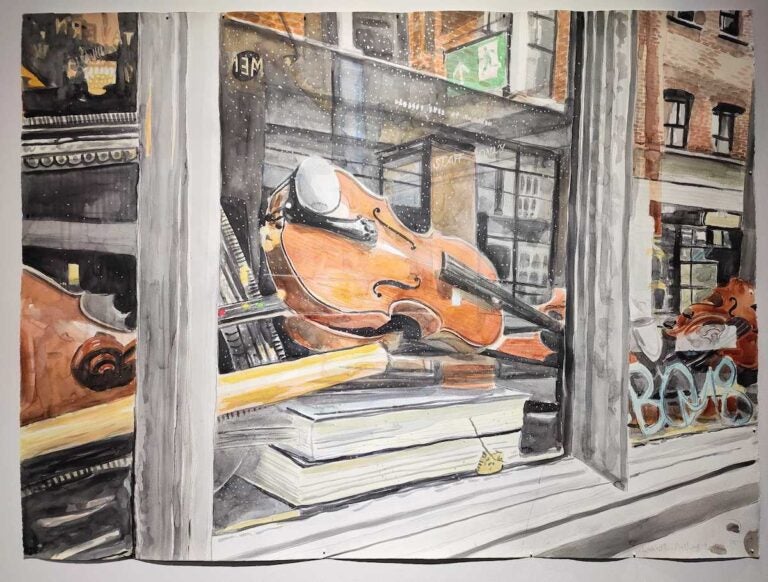
“Inside Outside Violins” (2019) by Meredith McNeal, who makes work related to the incarceration of her brother, who she says is innocent. (Peter Crimmins/WHYY)
From Philly and the Pa. suburbs to South Jersey and Delaware, what would you like WHYY News to cover? Let us know!
Trenton-based artist Chee Bravo is not a music aficionado, but is nevertheless drawn to musicians. Her art comes from snapshots she captures of performers, their bodies and faces melting into the rhythm and melody, as if the music itself is controlling their expressions.
“They get into that zone. They’re into their music,” she said. “They’re basically oblivious to the audience sometimes.”
But the singer in the painting Bravo submitted to the National Liberty Museum’s new exhibition, “Amplified: Music, Art, Power,” is forcefully direct with her audience, in this case the gallery visitor. The woman in “Havana – La Cantora” (2019) looks boldly from the canvas with her arm outstretched to the viewer making her seem to strain to hit the right note.
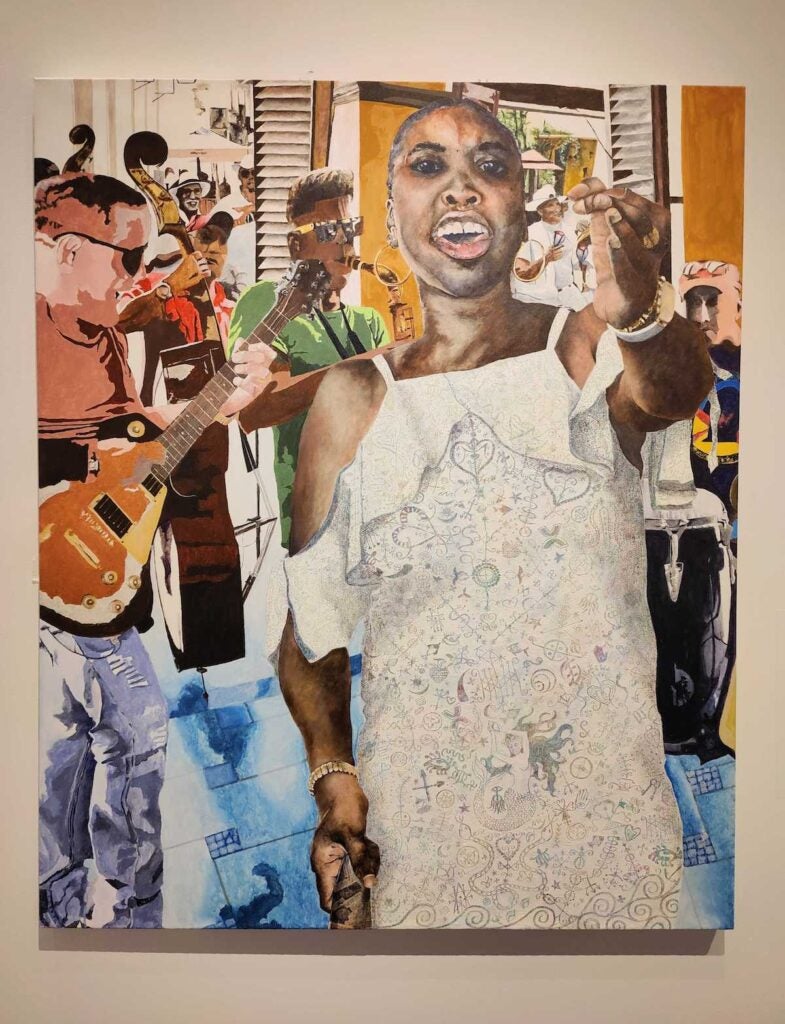
The painting is based on several photos Bravo took in Havana, Cuba. Originally the singer was wearing a different outfit — “a really boring flower top and beige pants,” Bravo said — so the artist instead painted her in a white dress, the color and countenance of someone who practices Santería.
Bravo grew up in Trinidad and Tobago at a time when Santería religious worship was not allowed in many Caribbean countries. Since the Cuban Communist ban on Santería was lifted in 1991, the practice has seen a resurgence on the island. About 70% of the population in Cuba observes some form of Santería or Afro-Cuban religious practice, according to the U.S. Commission on International Religious Freedom.
The white dress in the painting appears to be embroidered, but closer inspection reveals Bravo has carved into the layer of white paint with a sharp instrument, creating intricate patterns and symbols related to Santería practice, including a mermaid at the center: the Yoruban ocean goddess Yemaya.
“I tried to use the ones with the good intentions, not evil,” said Bravo, who does not practice Santería. “I wasn’t fearful but I respect what it is. I don’t quite understand it. I chose all the good symbols so that, hopefully, if anything was to happen it wouldn’t be a bad thing.”
“Amplified” is an expansion of the annual David Bowie fan art pop-up exhibition and sale, which the National Liberty Museum has been doing for four years in coordination with Philly Loves Bowie Week. Proceeds are donated to Children’s Hospital of Philadelphia.
The museum in Old City once again has a gallery of Bowie-related art, but chief program officer Elizabeth Grant wanted to take a deeper dive into the connection between music and liberty.
“Liberty is very abstract as a concept. In many ways music is as well,” Grant said. “There’s joy, there’s pain, there’s a sense of individual identity and collective community building.”
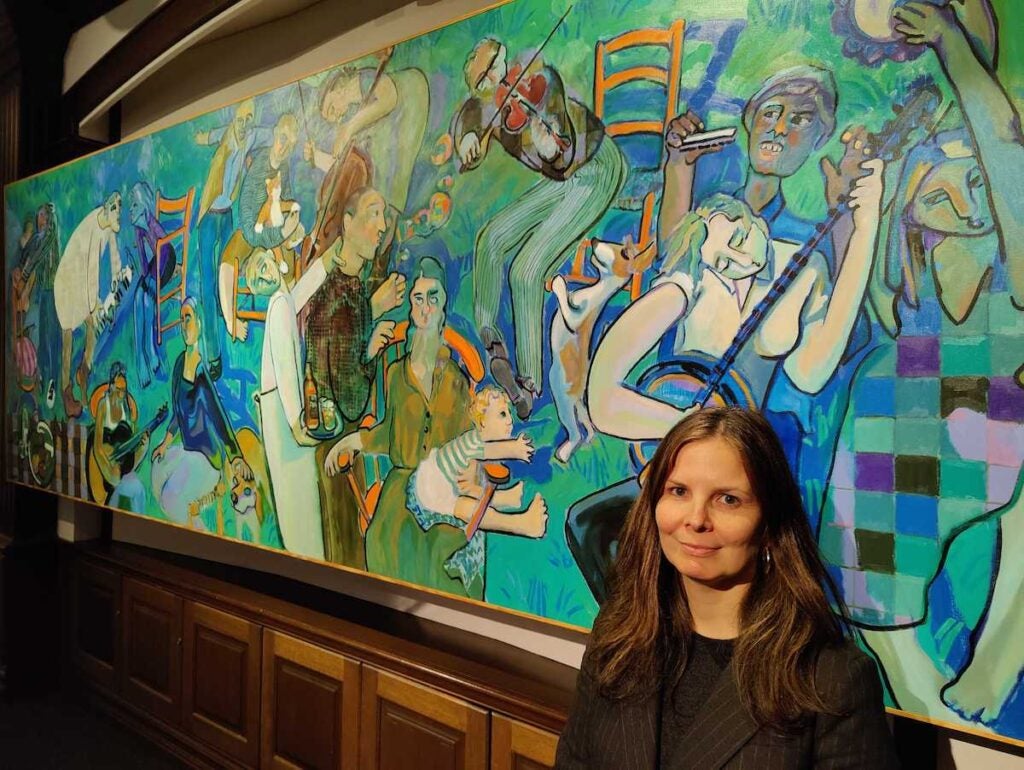
The gallery is dominated by a large, 15-foot-long canvas by Louisville-based artist Joyce Garner. “Musical Chairs” is populated by many figures, some playing acoustic instruments, in what appears to be an outdoor family barbecue. In its scale and arrangement of figures, The painting bears a casual resemblance to “Guernica,” Pablo Picasso’s monumental depiction of the horrors of the Spanish Civil War.
“’Musical Chairs’ is about bluegrass music, and the fundamentalism that split my family,” said the artist in a statement. “There are magical parts combined with more ‘realistic’ narratives of trauma and threats. Both are necessary.”
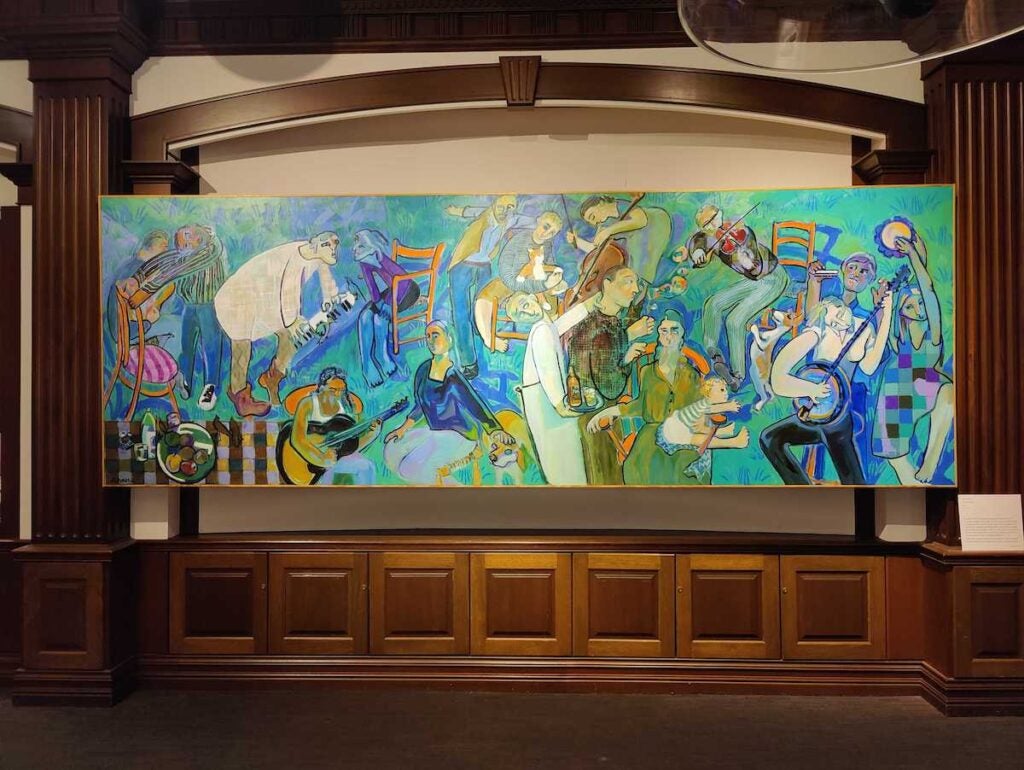
The show features “Inside Outside Violins” (2019), a large watercolor of violins lying on their sides seen through the panes of a shop window, as though they were trapped and ignored behind bars. For the last ten years much of Brooklyn-based artist Meredith McNeal’s work has been in response to her brother’s ongoing incarceration for an undisclosed serious crime, for which McNeal claims he was falsely convicted.
McNeal shares the wall with work by her brother, who is only identified as “Free Inside”: two prison-issued acoustic guitars that he decorated with collaged imagery fixed with acrylic and floor wax, as well as a prison-issued cup and spork utensil decorated the same way.
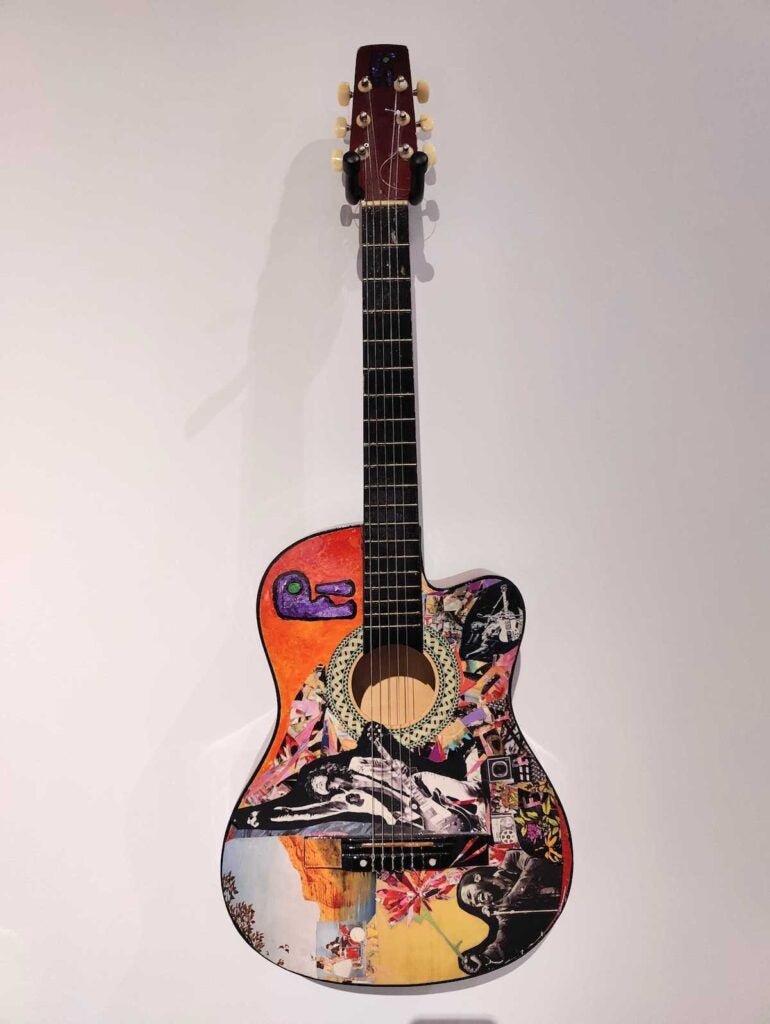
The pieces in “Amplified” were selected by a jury put together by the Liberty Museum, including DJs (Robert Drake and John Morrison of WXPN), a bar owner (Robert Perry of Tattooed Mom), the editor of an online culture and lifestyle magazine (Zindzi Harley of Zindzine), and Melissa Ziobro, curator of the Bruce Springsteen Archives at Monmouth University, N.J.
“Liberty is a collaborative effort,” Grant said. “We do our best to create opportunities and experiences to hear from people outside these walls.”
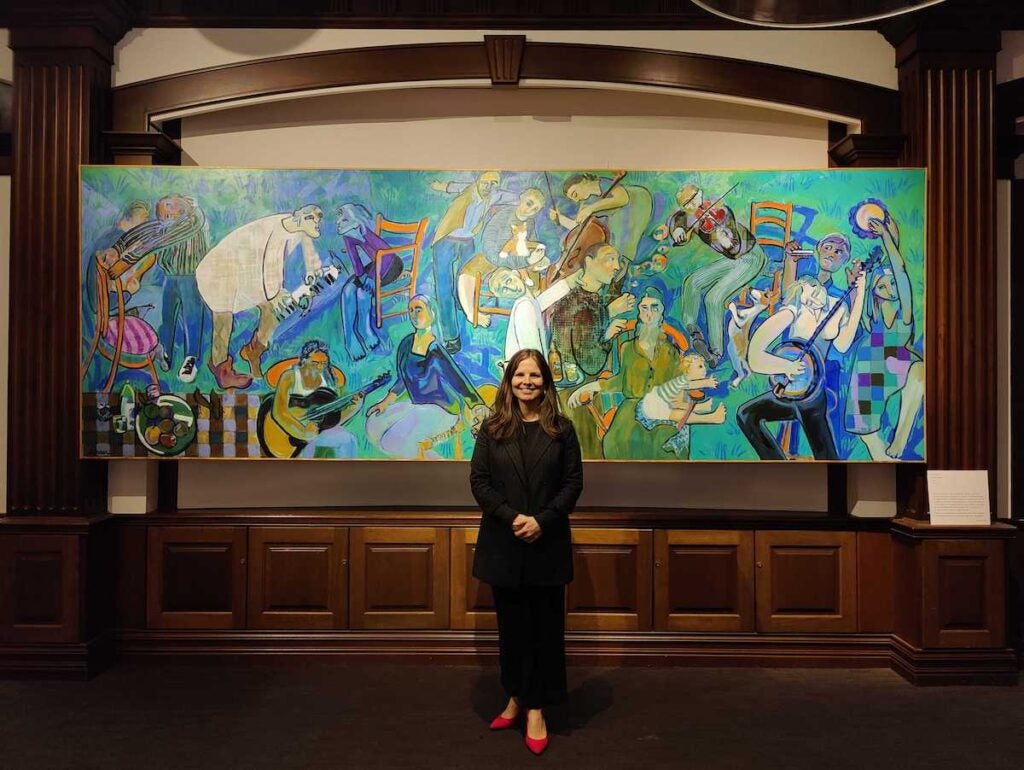
DJ Robert Drake said the submissions defied his expectations: Instead of works that attempted to tap into the role music has played in shaping social movements and national democratic ideals, he said the artists all took intimately personal perspectives.
“I was expecting it to be a little bit more driven by civil rights and human rights — and it is — but I think the backstory of each piece tends to explain a more personalized exploration of a human being’s rights,” Drake said.
His favorite piece is one that would not fit in the gallery. The New York-based artist Daniel Shieh arranged 30 identical transistor radios in a grid on a platform, each of them playing back The U.S. national anthem sung in 30 languages, including German, Italian, Polish, Yiddish, Spanish, Navajo, Samoan, and Lakota.
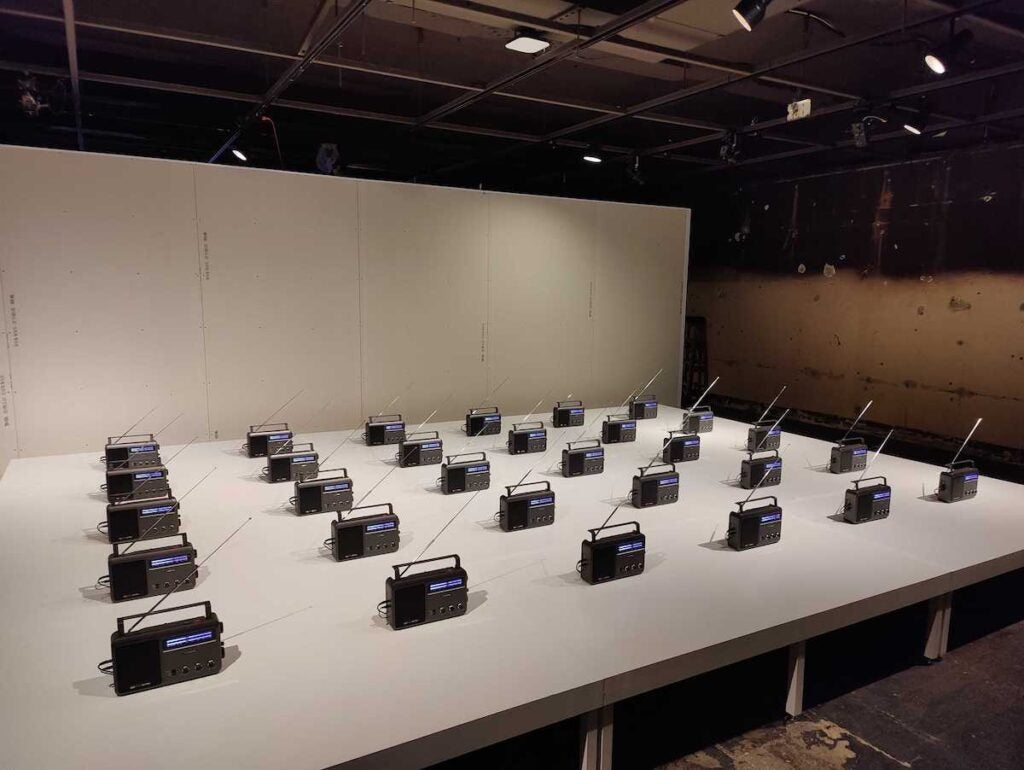
The sound loop, repeating every minute, blends into an unintelligible cacophony with spontaneous harmonies sometimes, jarring discord at other times. The artist said in a statement that different languages resonate with their own meanings: the Yiddish anthem might represent assimilation into a new country; the Indigenous versions could echo the forcible removal of Native tribes.
The Spanish version of the national anthem was commissioned by the U.S. Government in 1945, the same year the United States dropped its so-called “Good Neighbor” open-trade relations with South American countries and began more hostile, Cold War interventions.
“Mother’s Anthem” takes up so much space that the National Liberty Museum had put it in its own room across the hall from the main gallery, in a part of the building that is still undergoing renovations. The walls and floor are raw.
For Drake, who has been working at WXPN for 35 years, “Mother’s Anthem” was a happy landscape of old-school radios.
“That was a personal one that I was excited to have included,” he said. “I just thought it was such a unique way to make a point.”
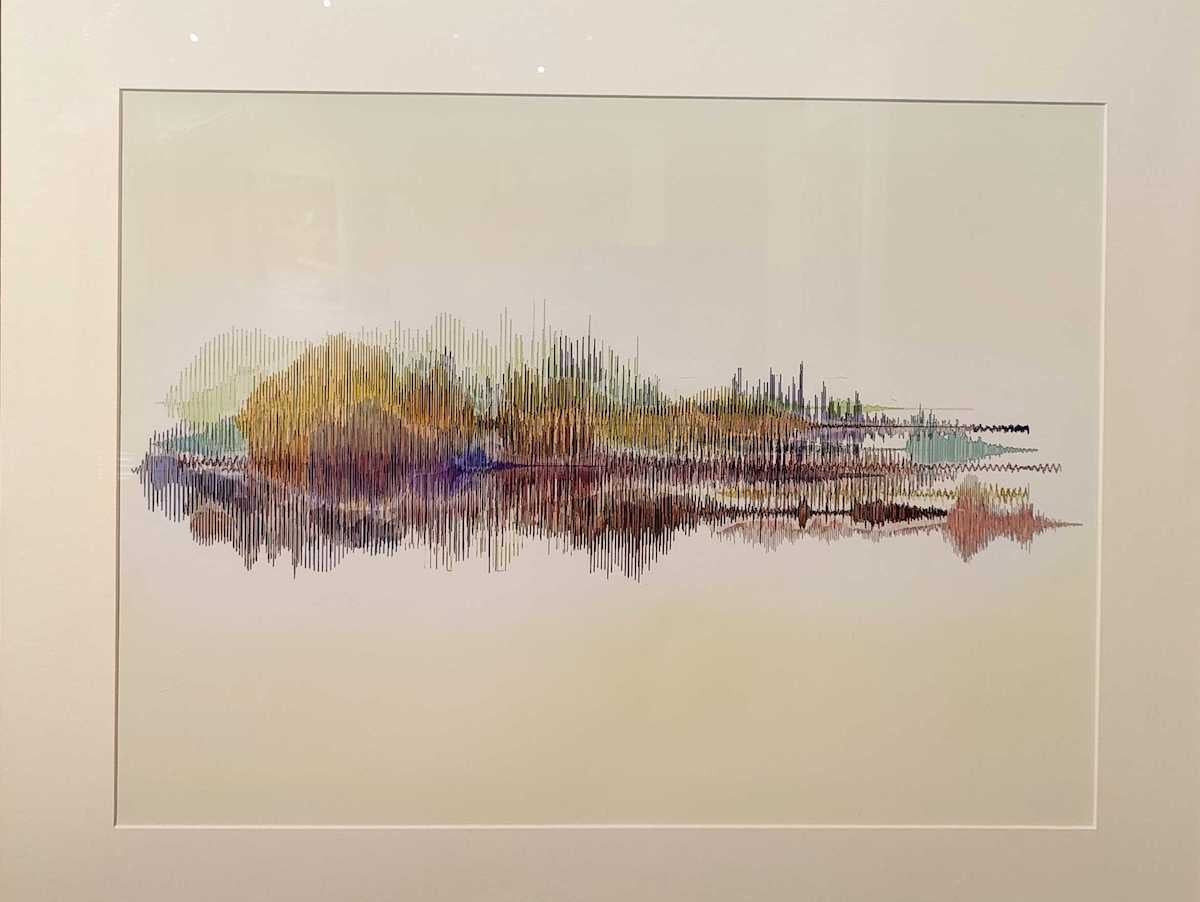
“Amplified: Art, Music, Power,” and the accompanying “Philly Loves Bowie Pop-Up Gallery and Art Sale” are on view from January 6 to April 8. It opens with “Bowie Bash,” a performance and reception party on Friday, January 5.

Get daily updates from WHYY News!
WHYY is your source for fact-based, in-depth journalism and information. As a nonprofit organization, we rely on financial support from readers like you. Please give today.



